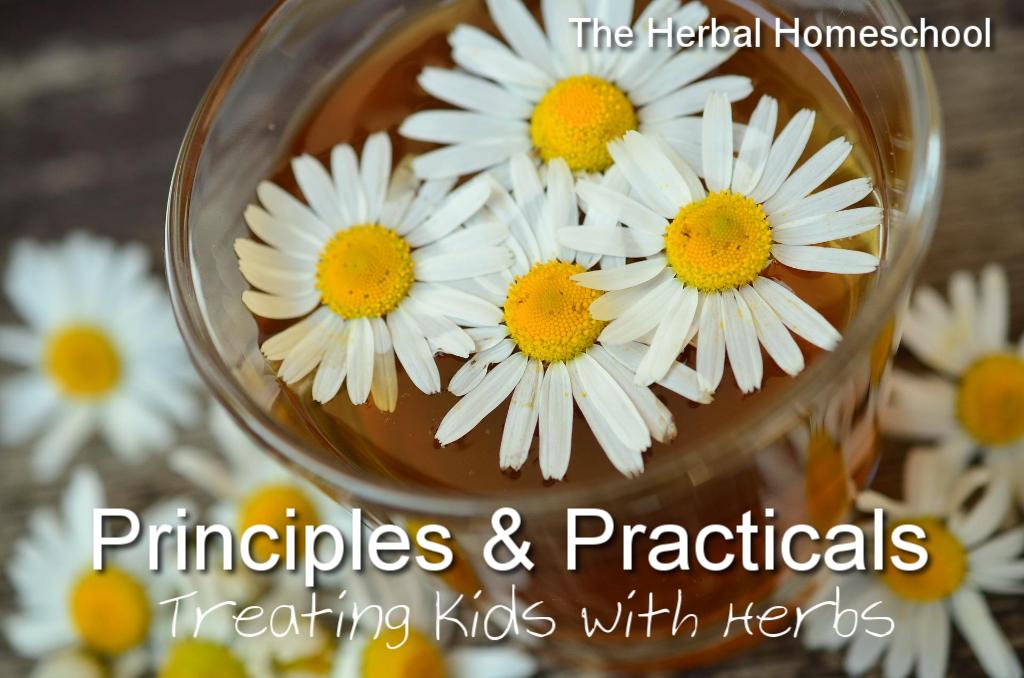Using Herbs for Babies & Kids
 -This post contains affiliate links-
-This post contains affiliate links-
Using herbs for kids can be incredibly beneficial, but also rather nerve-wracking. Sometimes it seems easier to just head to the pediatrician for some professional advice on your little munchkins’ earache or cough. Now I want to make it clear that I definitely believe conventional medicine has it’s place. However I also want to encourage you to educate yourself enough to be able to confidently treat the everyday issues that crop up like colic and colds, as well as provide complementary treatment for more serious issues that you decide to treat more conventionally.
Discussing EVERYTHING pertaining to using herbs with children or EVERY herb to use/avoid would be outside the realm of one blog post. That said, I do want to share some basic principles regarding using herbs for kids that can help guide your treatment. I also want to share a short list of go-to herbs that are considered very safe for babies & children. I will discuss using alcohol tinctures vs glycerites, methods for giving your kids the herbs, etc. in a future post. Both herbs & principles have been confirmed in multiple resources including Herbs for Children’s Health by Rosemary Gladstar and The ABC Herbal by Steven Horne
Principles For Treating Children with Herbs
– Use gentle herbs. Children are not necessarily just tiny adults. Their bodies seem to respond more sensitively to treatments. Children under two actually do not have completely developed livers yet, making it more difficult to break down the constituents in the herbs.
– focus on supporting the immune system, or other symptoms that may be in distress like the digestive system or respiratory system, not just eliminating symptoms. This is a general rule of thumb for using herbs in general really. The focus of using herbs should be to support your body so it will be able to come back into balance and heal itself from the root issue, not just knocking out bothersome symptoms. This slow & steady method has taken me some time to adjust too because I’m pretty impatient. Learning as much as you can helps so that you can confidently invest time in your herbal treatment with well-founded hope that it will work.
– Treat your child holistically; take every part of their current lifestyle into consideration and make healthy choices. For example, don’t give echinacea tincture for a cold, but then allow them to continue drinking quarts of milk (dairy produces mucus) or eating sugar. Incorporate rest, healthy foods, AND herbs. Really this applies to everyone, especially when you consider what we mentioned above about herbs supporting your body.
– To find the appropriate dosage to give your child, first find the appropriate dosage for an adult then use one of these formulas listed below to determine an accurate dose for your child. Both these methods are listed in many books, but I found these in Herbs for Children’s Health by Rosemary Gladstar.
– Young’s Rule; Add 12 to the child’s age, then divide the child’s age by this number. The resulting number is the percentage of the adult dose you would use. For example, for a 4 year old, you would add 12, then divide 4 by the resulting 16, equaling .25. Thus you would give the child 1/4 of the adult dose.
-Cowling’s Rule; Simply divide the child’s age at their next birthday by 24. Thus a 3 year old would be turning 4, so you would divide 4 by 24 equaling .16. So you would give the child 1/6 of the adult dose.
– Know what success using the herb will look like. Steve Horne from Tree of Light says to know what reaction you are looking for so that you can tell if it is working. For example, if you know that you are looking to induce sweating to help lower a fever, you will be able to judge your success more accurately than if you just know you are trying a random dose of herb X to break a fever. This will help you evaluate whether you need to switch herbs or adjust the dose as well.
Practical Treatment; a short list of safe herbs
The following herbs have been confirmed as being safe for children in multiple different resources including Herbs for Children’s Health and Mother Earth News
as well as “Dr. K’s” information on Montana Whole Health’s website (all great resources to check out by the way)
– Echinacea: for immune boosting at the first sign of a cold
-Elderberry: for immune support. See my post on Elderberry Syrup for more info.
-Calendula: for wound healing and use as an anti-inflammatory, antibacterial, and antifungal used topically
– Catnip: to relax and treat colic & teething issues.
-Chamomile: “the wonder herb” for all around soothing, digestive help, and as an essential oil rub for muscles
– Fennel: for use as an antacid. It is great for digestion to treat colic & gas.
-Lemon Balm; it is calming, antiviral, antiseptic, and is used as a mild sedative in tea.
-Licorice: great for soothing sore throats, lowering inflammation, and easing congestion.
-Mullein: as an infused oil for ear infections especially.
-Nettle: to benefit from it’s extremely high vitamin & mineral content and treat allergies & hay fever.
-Slippery Elm: for treating inflammation, burns, sore throat, digestive issues, diarrhea, and constipation.
Remember this is a short list of herbs that have been confirmed by multiple sources to start you off; don’t be afraid to research and use other herbs as well. Here are a few of my favorite resources . . .
I also want to add a disclaimer; I am not a medical professional and am not looking to give medical advice. I am merely compiling and sharing information that has helped me and sharing my experiences.

